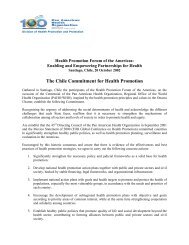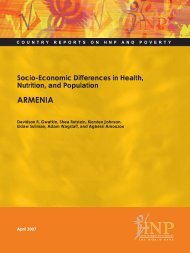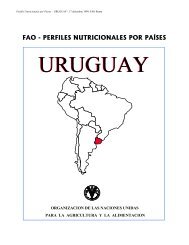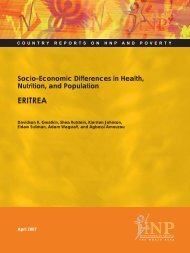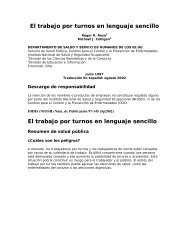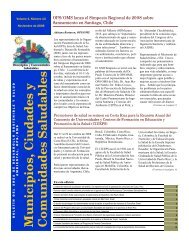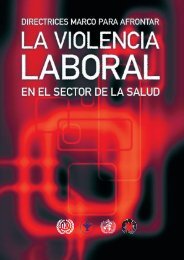Guidelines for drinking-water quality. Volume 1 - BVSDE
Guidelines for drinking-water quality. Volume 1 - BVSDE
Guidelines for drinking-water quality. Volume 1 - BVSDE
Create successful ePaper yourself
Turn your PDF publications into a flip-book with our unique Google optimized e-Paper software.
of acquiring an infective dose cannot be predicted from their average concentration in <strong>water</strong>.<br />
• The likelihood of a successful challenge by a pathogen, resulting in infection, depends upon<br />
the invasiveness and virulence of the pathogen, as well as upon the immunity of the individual.<br />
• If infection is established, pathogens multiply in their host. Certain pathogenic bacteria are<br />
also able to multiply in food or beverages, thereby perpetuating or even increasing the<br />
chances of infection.<br />
• Unlike many chemical agents, the dose response of pathogens is not cumulative.<br />
Because of these properties there is no tolerable lower limit <strong>for</strong> pathogens, and <strong>water</strong> intended <strong>for</strong><br />
consumption, <strong>for</strong> preparing food and drink, or <strong>for</strong> personal hygiene should thus contain no agents<br />
pathogenic <strong>for</strong> humans. Pathogen-free <strong>water</strong> is attainable by selection of high-<strong>quality</strong><br />
uncontaminated sources of <strong>water</strong>, by efficient treatment and disinfection of <strong>water</strong> known to be<br />
contaminated with human or animal faeces, and by ensuring that such <strong>water</strong> remains free from<br />
contamination during distribution to the user. Such a policy creates multiple barriers to the<br />
transmission of infection (see Chapter 6 <strong>for</strong> a more detailed discussion of the multiple-barrier<br />
concept).<br />
As indicated in section 1.3, although many pathogens can be detected by suitable methods, it is<br />
easier to test <strong>for</strong> bacteria that specifically indicate the presence of faecal pollution or the efficiency<br />
of <strong>water</strong> treatment and disinfection (see section 2.2). It follows that <strong>water</strong> intended <strong>for</strong> human<br />
consumption should contain none of these bacteria. In the great majority of cases, monitoring <strong>for</strong><br />
indicator bacteria provides a great factor of safety because of their large numbers in polluted<br />
<strong>water</strong>s; this has been rein<strong>for</strong>ced over many years of experience.<br />
2.2 Microbial indicators of <strong>water</strong> <strong>quality</strong><br />
2.2.1 Introduction<br />
Frequent examinations <strong>for</strong> faecal indicator organisms remain the most sensitive and specific way<br />
of assessing the hygienic <strong>quality</strong> of <strong>water</strong>. Faecal indicator bacteria should fulfil certain criteria to<br />
give meaningful results. They should be universally present in high numbers in the faeces of<br />
humans and warm-blooded animals, and readily detectable by simple methods, and they should<br />
not grow in natural <strong>water</strong>. Furthermore, it is essential that their persistence in <strong>water</strong> and their<br />
degree of removal in treatment of <strong>water</strong> are similar to those of <strong>water</strong>borne pathogens. The major<br />
indicator organisms of faecal pollution - Escherichia coli, the thermotolerant and other coli<strong>for</strong>m<br />
bacteria, the faecal streptococci, and spores of sulfite-reducing clostridia - are described briefly<br />
below. Details of additional microbial indicators of <strong>water</strong> <strong>quality</strong>, such as heterotrophic plate-count<br />
bacteria, bacteriophages, and opportunistic and overt pathogens, are given in <strong>Volume</strong> 2 of<br />
<strong>Guidelines</strong> <strong>for</strong> <strong>drinking</strong>-<strong>water</strong> <strong>quality</strong>.<br />
2.2.2 General principles<br />
While the criteria described above <strong>for</strong> an ideal faecal indicator are not all met by any one<br />
organism, many of them are fulfilled by E. coli and, to a lesser extent, by the thermotolerant<br />
coli<strong>for</strong>m bacteria. The faecal streptococci satisfy some of the criteria, although not to the same<br />
extent as E. coli and they can be used as supplementary indicators of faecal pollution or<br />
treatment efficiency in certain circumstances. It is recommended that E. coli is the indicator of first<br />
choice when resources <strong>for</strong> microbiological examination are limited. Because enteroviruses and<br />
the resting stages of Cryptosporidium, Giardia, amoebae, and other parasites are known to be<br />
more resistant to disinfection than E. coli and faecal streptococci, the absence of the latter<br />
organisms will not necessarily indicate freedom from the <strong>for</strong>mer. Spores of sulfite-reducing<br />
clostridia can be used as an additional parameter in this respect.




